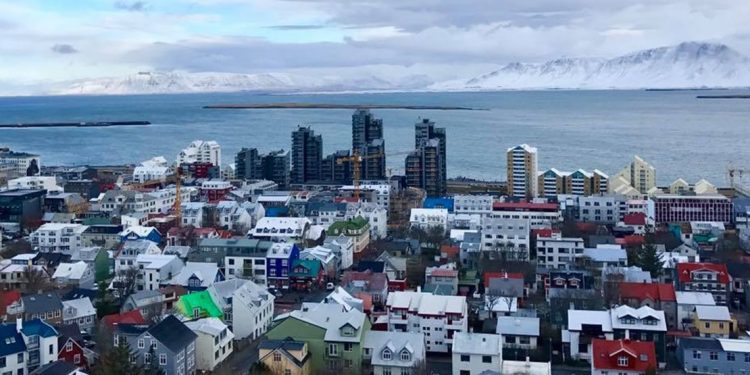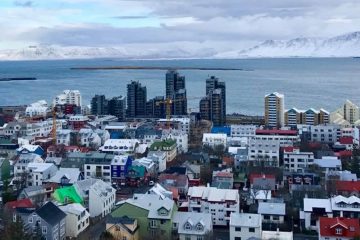
Discover Why Iceland Is on So Many Bucket Lists
Iceland’s name is a bit of a misnomer. It actually has a fairly mild climate for its northern locale, and in the summer it boasts a practically endless intensely green landscape dotted with other-worldly volcanic rock formations, glacial rivers and cascading waterfalls.
It’s also become one of the hottest vacation destinations on the planet, in particular for traveling alone. But for a country that many people don’t know much about, it can be difficult to know what to do in Iceland.
If you’re fortunate enough to be making a trip to this “Land of Fire and Ice,” be sure to experience these Iceland points of interest.
Hallgrimskirja Church, Reykjavik
When visiting Iceland, you’ll likely begin your journey in the colorful capital of Reykjavik. There are plenty of things to do in Reykjavik to keep you entertained, but one of the best ways to start your trip is to take in the panoramic view from the top of Hallgrimskirkja Church.
You’ll not only be able to soak up the gorgeous vista of the city, the sea and soaring mountains beyond, but it’s a great way to get a perspective of the city’s layout before visiting its shops, galleries and unique museums like the Icelandic Phallological Museum.
Located atop Skolavorduhaed Hill, this impressive church was inspired by the beautiful columnar basalt of Svartifoss waterfall. In front of the church is a statue of Leif Ericsson, an early explorer who discovered North America in the year 1,000, centuries before Christopher Columbus.
After you’ve taken in the view, get a taste of community by visiting the Northern Lights Bar at the ION Luxury Adventure hotel, one of the best pubs in the world.
Soak in the Blue Lagoon
Located just a short drive or shuttle bus trip from Keflavik International Airport, the Blue Lagoon may be touristy, but it’s really not-to-be-missed when it comes to things to do in Iceland. Ideal for soaking away jet lag after you arrive, or saving for the grand finale, Iceland’s most famous pool offers an unforgettable experience.
Soothe your cares away in the milky, warm, aquamarine waters that are surrounded by black lava rocks, occasionally swimming out to the bar that sits in the middle of the lagoon to sip strawberry champagne, enjoy a beer or healthier beverages like green smoothies.
Take the experience up a notch by requesting an in-water massage or indulging in one of the many skin enhancing treatments like volcanic rock scrubs and algae face masks.
Brimming with culture and history, when you visit London you are sure to have enriching experiences. Here's what to know when planning your trip!
The Golden Circle
This approximately 100-mile-long route boasts some of the nation’s most stunning sights, including waterfalls and geysers. The Continental Divide is also along this route, where you can actually walk on a path in the rift valley between the North American and Eurasian plates.
You can even go diving in the strikingly clear waters that have been filtered through the surrounding lava fields from a nearby glacier.
The Haukadalur geothermal area is another highlight, home to two famous geysers, Geysir and Strokkur. Geysir, the original geyser for which all the others were named, no longer erupts, but Strokkur explodes about every 10 minutes, shooting water 100 feet into the air.
Visitors can also walk along the path to the geysers and spot numerous vents with steam rising from the earth, as well as mud pots and fumaroles.
Golden Falls, or Gullfoss Falls, is just a short drive from the geysers. Its powerful waters plunge 100 feet into a canyon, producing a thick mist and frequent rainbows.
The South Coast
The South Coast is truly what dreams are made of, making it a main feature of Iceland tourism. You’ll have the chance to stand in awe of some of the most breathtaking waterfalls on the planet, like Seljalandsfoss, which is fed by melting water from the glacier-capped Eyjafjallajokull volcano.
It’s a favorite with many, as visitors can walk the path that runs behind the powerful cascade, gazing through the veil of water out to the scenic Icelandic landscape.
Just 20 miles further south is another famous waterfall: Skogafoss. By climbing the 370 steps to the top of the waterfall that plummets nearly 200 feet into a pool below, you’ll be rewarded with a panoramic view of the coastline.
Standing at its base along the river, you’ll be enveloped by the roaring sound of water and a cloud of spray. On a sunny day, a rainbow often develops in the mist, providing an ideal photo-op.
The world-famous shores of Reynisfjara are home to one of the country’s most spectacular volcanic black-sand beaches, located just south of the village of Vik. The sands were created by hot lava that flowed into the chilly waters of the Atlantic, causing it to harden in tiny fragments.
You’ll also see a unique cliff of basalt columns that resemble a rocky step pyramid, similar to Northern Ireland’s Giant’s Causeway.
Jokulsarlon Glacier Lagoon often serves as the turn-around point for travelers who aren’t continuing along the Ring Road. This large glacial lagoon was created by glacier melt a half-century ago, and in the warmer months, it can be explored via a zodiac boat tour.
The icebergs are continuously breaking off the glacier, where they drift through the short river before heading into the sea. The thundering sound they make as they crash to the water must be experienced to believe.
This was the site of a number of films and TV shows, including HBO’s “Game of Thrones,” “View to Kill” and “Tomb Raider.”
Iceland’s North
Iceland’s Northern region is well worth visiting and can be reached by driving the Ring Road, or taking a short, inexpensive flight from Reykjavik. Base yourself in the “Capital of the North,” Akureyri, and you’ll be within a couple hours’ drive of numerous attractions.
Soak in the more secluded and tranquil Lake Myvatn Nature Baths — the north’s alternative to the Blue Lagoon. It’s far less touristy and offers the chance to soak in natural geothermally heated pools surrounded by volcanic landscape and dramatic mountains.
The more adventurous may want to bring a flashlight and visit Grjotagia cave, which features a natural hot spring inside for soaking.
Nearby, Hverfell Crater offers the chance to hike to the rim of one of the world’s best preserved volcanic craters, while the Hverir Geothermal Area boasts fumaroles and boiling mudpots in a terrain that’s absolutely surreal with its cracked ground a mosaic of green, red, orange, yellow and white.
The north is also home to some very impressive waterfalls: Dettifoss, one of Europe’s largest waterfalls, and Godafoss, both of which are must-sees.
Most people don't give too much thought to which hotel they book. But the uniqueness of these cool hotels will be the highlight of your trip!
The Snaefellsnes Peninsula
It would be hard to find a more magical setting than the Snaefellsnes Peninsula in the west of Iceland, with its dramatic sea cliffs, pristine fjords, soaring volcanoes and countless waterfalls. Kirkjufellsfoss and the surrounding region was what inspired Jules Verne’s “Journey to the Center of the Earth.”
Located near iconic Mount Kirkjufell, which is often used as the image to market Iceland to travelers, many say it’s the most impressive sight they’ve ever seen. It’s even grander in light of the midnight sun of the mid-summer months.
Other highlights on the peninsula include Vatnshellir cave, an 8,000-year-old lava tube that stretches for over 650 feet into the ground. There’s also the Snæfellsjokull glacier, an active volcano and a massive glacier that stands more than 4,744 feet high and is said to be one of the seven greatest energy centers on Earth.
If you take a tour with Extreme Iceland, your guide may even bring you to a “secret” hidden waterfall and a natural carbonated spring where you can fill your cup and sip the refreshing water right from the ground.
